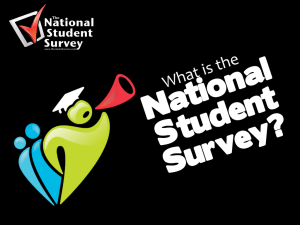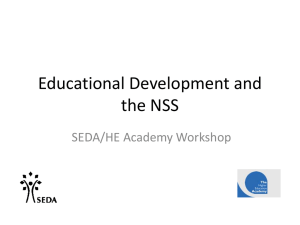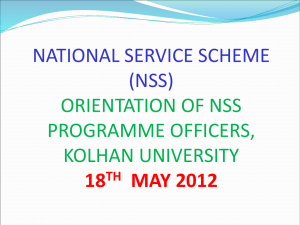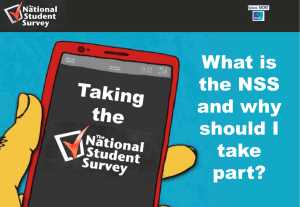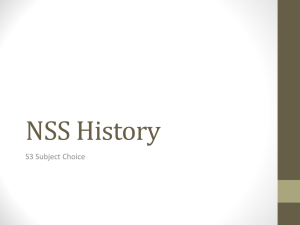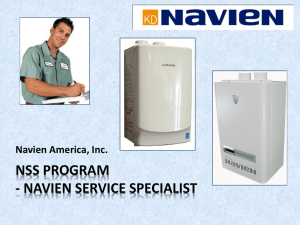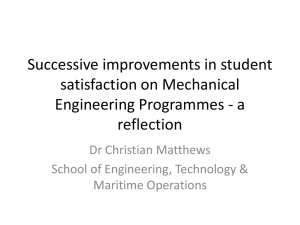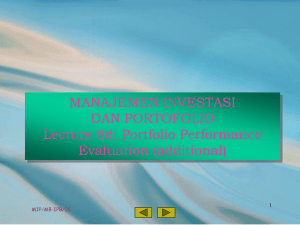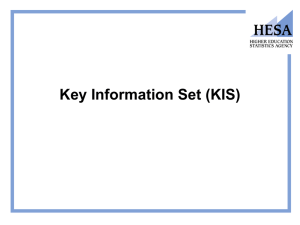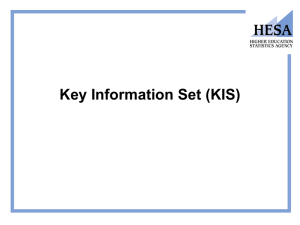Plenary: Teaching, Learning and Assessment
advertisement
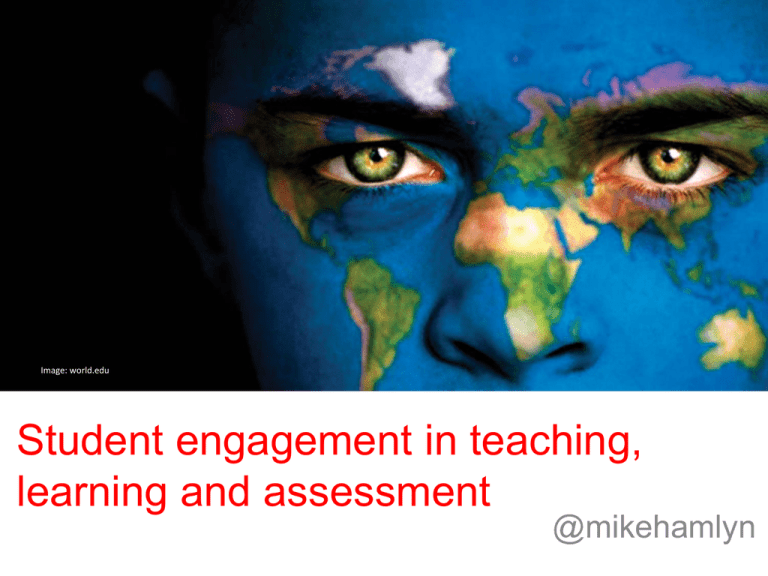
Image: world.edu Student engagement in teaching, learning and assessment @mikehamlyn Outline Individual engagement retention and success a sense of belonging Benefits of engagement for the individual and society Engagement Outcomes Module and award level Public informatiion League Tables What can we do with the data portfolio performance how to get “smart” how to improve outcomes from better engagement The future How will we carry on? Is this engagement? How do you know? Does this reflect reality? What will engaged students look like in the future? Individual Engagement • Student Retention and Success Project • 1. At the heart of student retention and success is a strong sense of belonging in HE for students. This is most effectively nurtured through mainstream activities that all students participate in. • 2. The academic sphere is the most important site for nurturing belonging. • 3. Specific interventions cannot be recommended over and above each other. Rather the institution, department and programme should all nurture a culture of belonging. • 4. Student belonging is an outcome of: supportive peer relations; meaningful interaction between staff and students; developing knowledge, confidence and identity as successful HE learners; and an HE experience which is relevant to interests and future goals. Benefits of engagement Engaged students get better outcomes Celebrating individual success Maximising individual rewards Maximising contribution to society Market and non-market benefits https://www.gov.uk/government/uploads/system/uploads/attachment_data/file/25410 1/bis-13-1268-benefits-of-higher-education-participation-the-quadrants.pdf How do we do this in a region of low aspiration? Engagement Outcomes Engagement Outcomes • Students act increasingly as engaged consumers – Access price comparisons – Access to performance comparisons – Demand better outcomes • University needs to optimise – Module and award level outcomes – Student survey results – Public information – League Tables An engaged student reads….. An engaged student contributes to… Inputs Outcomes Spend per student Staff student ratios Entry standards Research ratings Cost of living Spend on services Faculty spend Number of “good” degrees National Student Survey results Retention rates Employability Student Input to Information • National Student Survey – – – – • • • Measure of final year students Questions on satisfaction with course Satisfaction with teaching and learning Satisfaction with assessment and feedback Degree results Retention Employability Used in 3 areas: – League tables/KIS (external) – Portfolio performance review (internal) – Award annual monitoring (internal) League Tables – a mirror. League Tables Overall Position in Guardian Guide 0 20 Ovwerall Position 40 60 80 100 120 Staffordshire 2008 2009 2010 2011 2012 2013 2014 74 67 55 69 77 96 92 NSS Teaching (%) 87.0 86.0 85.0 84.0 83.0 82.0 81.0 80.0 79.0 78.0 77.0 NSS Teaching (%) 2010 2011 2012 2013 2014 81.6 80.5 82.0 83.3 86 67/119 NSS Overall (%) 86.0 84.0 82.0 80.0 78.0 76.0 74.0 NSS Overall (%) year 2010 2011 2012 2013 78.0 81.8 80.0 85 62/119 NSS Feedback (%) 74.0 72.0 70.0 68.0 66.0 64.0 62.0 60.0 58.0 NSS Feedback (%) 2010 2011 2012 2013 2014 63.3 65.4 66.3 68.3 72 38/119 Student: staff ratio 22.0 21.5 21.0 20.5 20.0 19.5 19.0 18.5 18.0 17.5 Student: staff ratio 2010 2011 2012 2013 2014 19.1 19.0 21.7 21.6 20.3 83/119 Entry Tariff 260.0 255.0 250.0 245.0 240.0 235.0 230.0 225.0 Entry Tariff 2010 2011 2012 2013 2014 249.4 235.8 238.5 245.5 254 107/119 Career prospects (%) 70.0 60.0 50.0 40.0 30.0 20.0 10.0 0.0 Career prospects (%) 2010 2011 2012 2013 2014 65.2 63.2 56.4 55.1 48 113/119 Value added score/10 6.0 5.0 4.0 3.0 2.0 1.0 0.0 Value added score/10 2010 2011 2012 2013 2014 5.2 5.2 4.7 4.0 3.8 108/119 Are we trying to improving position or performance? • Clearly, we can try to play the game of moving our league table position • What we really want to do is improve our performance in each of the key areas to make sure there is a sustainable and genuine change Guardian criteria Suggested Action Entry standards Review all current standard offers to pitch ourselves properly against competitors Student/staff ratio Reviewed more thoroughly the data we submit to HESA Developing better models of SSR to identify where investment is most needed Spend per student Reviewed more thoroughly the data we submit to HESA Reviewed classification of spend Increased recent spend on libraries and IT will have an impact Guardian criteria Action Value added Increased number of “good” degrees awarded. Reviewing all level 6 modules with low pass rates and average marks. Identifying through portfolio review awards with consistently poor progression and attainment L&T conference on attainment BME student performance NSS teaching, assessment and feedback and overall satisfaction Faculty action plans, and award level plans Increased student engagement with survey Seven principles of feedback Online assessment and feedback project Review through portfolio performance tool employment Staffordshire Graduate – improving our students’ chances of success On-campus graduate internships Student Input to Information Used in 3 areas: – League tables/KIS (external) – Portfolio performance review (internal) – Award annual monitoring (internal) Portfolio performance review • Measures: • Uses – Market – Academic outcomes inc good degrees – Student satisfaction – Employability SNC/AB B 2nd stage enrol per offer 0.5 0.22 0.12 0.42 total apps/2 nd retenti retenti % good % good stage on on progres progres degree degree enrol 2011 2012 s 2011 s 2012 s 2011 s 2012 5 9.50 16.00 3.40 90.0 90.0 90.0 90.0 56.0 60.0 100.0 93.3 100.0 100.0 86.4 77.8 100.0 80.0 100.0 100.0 72.7 77.8 66.7 25.0 50.0 50.0 66.7 25.0 – Comparison against targets – Comparison between awards – Annual monitoring – Portfolio decisions NSS 2012 total all total all total all total all NSS assess levels levels levels levels dlhe dlhe 2012 and NSS enrol enrol enrol enrol 2010- 2011- teachin feedba 2012 2010 2011 2012 2013 11 12 g ck overall 10 27 9 10 28 7 8 21 9 9 14 9 NSS 2013 score 2 assess and NSS score 1 market quality led NSS 2013 feedba 2013 led (enter teaching ck overall target below) 80 85 86 70 85 86 72 85 80.00 100.0 50.0 0.0 80.0 0.0 50.0 78.0 97.0 78.0 65.0 94.0 65.0 75.0 100.0 75.0 89.0 83.0 89.0 74.0 85.0 74.0 90.0 87.0 90.0 80.87 60.71 94.68 100.69 81.83 79.92 Student Input to Information Used in 3 areas: – League tables/KIS (external) – Portfolio performance review (internal) – Award annual monitoring (internal) Annual Monitoring • Key part of quality process – Reflection on award performance – Reflection on student engagement and outcomes • • • • • Statistics – progression, achievement, retention Response to external examiner comments Reflection on employer input Staffordshire Graduate Reports are made available to students, to demonstrate our engagement • Critically important for partner input, and to recognise joint responsibility for improvements How it fits together Student surveys Student satisfaction Action Plans Student engagement and outcomes League tables Annual Monitoring Course improvements reputation Market demand Improved engagement leads to improved outcomes • improved outcomes for individual students – Grades and classifications – Employability –getting into the right jobs – Satisfaction – Satisfying aspirations • improved overall outcomes – Institutional success and reputation – Changing the aspirations of our communities How institutional data and analysis can help? • Identifying performance metrics at module level • Identifying performance metrics for awards • Developing a culture where this analysis becomes embedded – Being prepared to deal with the issue! TLA practice Relevant TL and assessment practice Responsive curricula – employer and technology led Management Intervention Questioning low average marks, poor attainment rates Managing the performance of the portfolio Increased student engagement in course design and monitoring Increased emphasis on EEE (staff and students) Staff engaged in reflective practice Improving quality of teaching Continuous staff development How could we improve engagement and outcomes for institution? Uses of technology Electronic assessment and feedback Online communities The future….. How we teach in 2013? Student portal How to learn in 2020? Mobile technologies Improving individual engagement Using “big data”? Learning Analytics – can work if all systems joined up A way to encourage or check on student engagement? Every log in Every use of VLE – pages read, scores on formative tests Use of library – frequency, downloads, loans Attendance at class or online A way to audit teaching as well……. Or is this another example of technological solutionism? LEADERSHIP AND LEARNING ANALYTICS, http://www.educause.edu/library/resources/leadership-and-learning-analytics “To Save Everything, Click Here: Technology, Solutionism, and the Urge to Fix Problems that Don’t Exist” Evgeney Morozov, pb Allen Lane 2103, ISBN-10: 1846145481” How will we engage students in learning when: Half of what they learn in first year is out of date by the time they graduate? They will have maybe 10 different jobs in their career? The jobs they will do don’t even exist yet using technology that isn't invented yet, to solve problems we don’t know are problems yet. 100 Billion queries a month on Google – who did we ask before? 90% of the data in the world was created in the last 2 years There are more students in the top 5% in China than all the students in the UK http://vimeo.com/58839986 @mikehamlyn blogs.staffs.ac.uk/mgh1/
